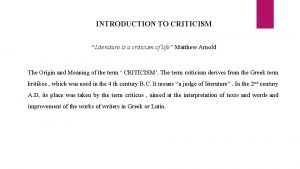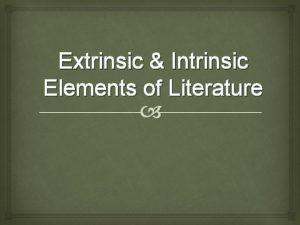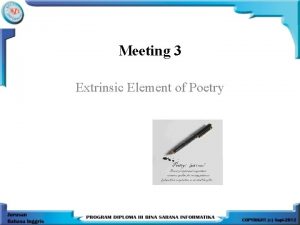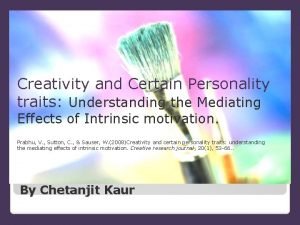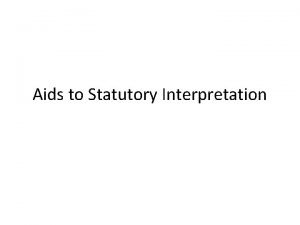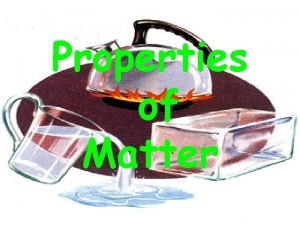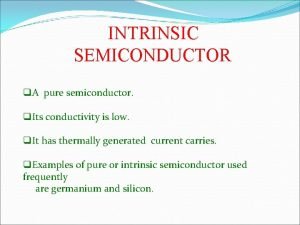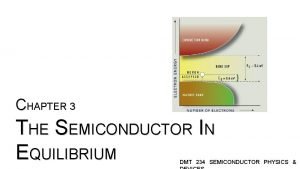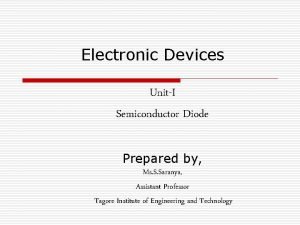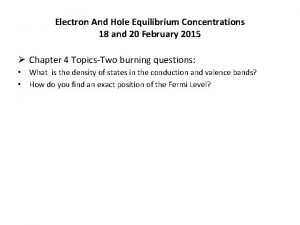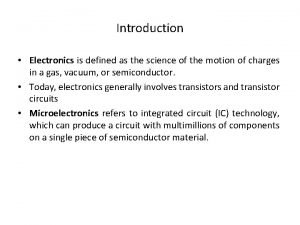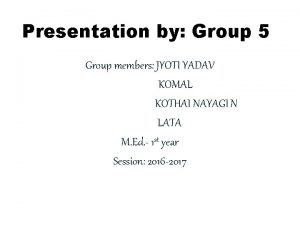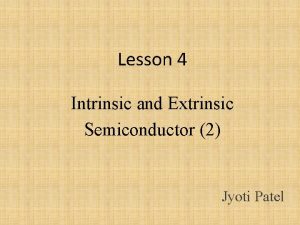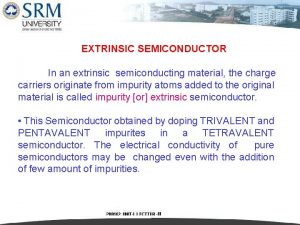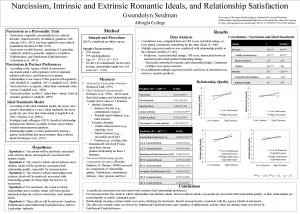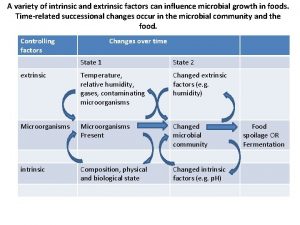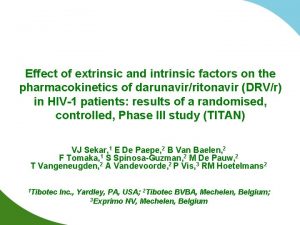Lesson 3 Intrinsic and Extrinsic Semiconductor 1 Jyoti























- Slides: 23

Lesson 3 Intrinsic and Extrinsic Semiconductor (1) Jyoti Patel

ØElectrical Properties of Ge and Si Properties Atomic No. Density of atoms Intrinsic concentration at 300 k Intrinsic Resistivity at 300 k Leakage current Maximum operating temperature Ge Si 32 4. 421 x 1022 2. 5 x 1013 14 5 x 1022 1. 5 x 1010 45 2, 30, 000 µA 75˚C n. A 175˚C

ØWhy Si is preferred than Ge? • • • Smaller Leakage current. High power handling capacity. High temperature applications. Plenty available on the surface of earth. Cheaper or economical. Favorable property to form Si. O 2 Ø Disadvantage of Si : • Si when exposed at 1400˚C temperature, it melts and when reacted with O 2 gives Si. O 2 Si (1400˚C ) + O 2 = Si. O 2

Que : IC fabrication in Si. O 2 is for providing what? Ans : For providing Insulation Ø Intrinsic Semiconductor • Also called as non-degenerate semiconductor. 1. Crystalline structure at 0 k

• Sharing of electrons with neighboring atoms is called Covalent Bonding. • In 1 Covalent bond there will be 2 valence electrons. • At 0 k all valence electrons are in perfect covalent bonding. So at 0 k will be working as an Insulator. 2. Crystalline structure at 300 k

• When covalent bond is broken it will create 1 electron and 1 hole. • Hole is defined as deficiency of an electron in the broken covalent bond. • In Intrinsic Semiconductor (n = p = ni) 3. Intrinsic Conductivity σi = nq. µn + pq. µp , but(n = p = ni) σi = ni q[µn + µp] σi α ni ni α T 3/2 • Hence, ni increases with temperature as a non linear variation.


• Free electron and hole both will disappear and covalent bond is created. 7. Carrier life time (τ) • Interval of time from breaking of its covalent bond untill it’s recombination. • Range is from microseconds to milliseconds. 8. Disadvantage of Intrinsic Semiconductor • Conductivity is very small Note: The only Semiconductor device fabricated with Intrinsic Semiconductor is Pin Diode

Ø Doping • Adding impurities to the semiconductor is doping. • Increase carrier concentration. • Standard doping levels - Moderate doping = 1 : [106 to 108] - Lightly doping = 1 : 1011 - Highly (Heavily) doping = 1 : 103 • Minimum doping required to convert intrinsic into extrinsic semiconductor is 1 : 108 • Que : Moderate doping refers to? Ans : a) 1 : 106 b) 1 : 105 c) 1 : 103 d) 1 : 108

• Impurity types - Trivalent/acceptor Impurities : B - Pentavalent/donor Impurities : P Al As Ga Sb In Bi • Que : Conductivity Increase by how much with 1 : 108 doping in Ge ? Ans : Increases by 12 times Ø Extrinsic Semiconductor • Also called as degenerate semiconductor/Doped Semiconductor Two types : N type SC/Donar P type SC/Acceptors

a) N-Type SC/Donar • Impurity is pentavalent. 1. Crystalline structure at 0 k

• Donar Energy level is a discrete energy level created just below the C. B • Free electron is having a force of attraction to parent atom. • At 0 k the 5 th electron will be existing in the donar energy level. • 5 th electron is not in covalent bonding and even its not free electron but it is a bonded electron to a parent atom. • At 0 k the 5 th electron of all impurity atoms exist in the donar energy level. • Que : How much additional energy is required to detach the bonded electron? Ans : 0. 01 for Ge and 0. 05 for Si

2. Crystalline structure at 300 k

• Donar energy level Ionisation : Refers to the 5 th electron moving from donar energy level to the conduction band. • Donar level Ionisation increase with increase in temperature. • At 300 k the 5 th electron of all the impurity atoms has shifted from donar energy level into C. B and donar energy level will become empty energy level. • Above 300 k there is no donar level Ionisation. • Que : Why it’s n>>p in N type semiconductor? Ans : The conc. of free electrons in C. B is far greater than the conc. of holes in V. B. So, electrons are the majority carriers and holes are minority.

• Majority carriers will contribute more current with less noise. • Minority carriers will contribute less current with less noise. • Minority carrier noise is thermal noise and it increase with the temperature. • Conductivity due to minority carriers is almost negligible. So, Majority > 99. 99 % Minority < 0. 01 % • The condition for n type semiconductor is : n > ni p < ni

3. Law of electrical Neutrality ND + P = N A + N Where, ND = density of donar atoms NA = density of acceptor atoms So, here NA = 0 ND + p = n Or n ≈ ND 4. Conductivity of N – type semiconductor σN = nq. µn + pq. µp σN ≈ ND q. µn

b) P-Type SC/Acceptor/+ve Type SC • Impurity is trivalent. 1. Crystalline structure at 0 k

• Acceptor Energy level is discrete energy level created just above the V. B • Acceptor Energy level is energy level of trivalent atoms added to the semiconductor. • P Type SC at 0 k will be working as an insulator. • Every impurity atom will be receiving one electron to complete its covalent bonding so P type is also called as acceptor. 2. Crystalline structure at 300 k • At 300 k because of thermal energy large no. of covalent bonds will be broken and equal no. of electrons and holes are created.

• These electrons will be moving from V. B into Energy level to complete the bonding and very few electrons will be moving from V. B to C. B

• Hole concentration in V. B is greater than electron concentration in C. B • Conductivity due to minority carriers is almost negligible. So, Majority > 99. 99 % Minority < 0. 01 % • The condition for p type semiconductor is : P > ni n < ni • Therefore, Holes -> Majority carriers Electrons -> Minority carriers

3. Law of electrical Neutrality ND + P = N A + N Where, ND = density of donar atoms NA = density of acceptor atoms So, here ND = 0 NA + n = p Or p ≈ NA 4. Conductivity of P-Type semiconductor σP = nq. µn + pq. µp σP ≈ NA q. µp

• Que : N-Type Semiconductor is? Ans : a) negatively charged b) Positively charged c) No charge at all d) Electrically neutral • Que : N-Type Semiconductor is? Ans : Electrically neutral

Thanks For Watching
 Intrinsic vs extrinsic semiconductor
Intrinsic vs extrinsic semiconductor Lintrinsic
Lintrinsic What is expressive criticism
What is expressive criticism Intrinsic elements meaning
Intrinsic elements meaning Extrinsic parameters of food
Extrinsic parameters of food Extrinsic elements of novel
Extrinsic elements of novel Intrinsic and extrinsic character traits
Intrinsic and extrinsic character traits Extrinsic and intrinsic aids to statutory interpretation
Extrinsic and intrinsic aids to statutory interpretation Intrinsic feedback
Intrinsic feedback Chapter 9 motivation and emotion quiz
Chapter 9 motivation and emotion quiz Intrinsic property
Intrinsic property Intrinsic semiconductor
Intrinsic semiconductor Intrinsic semiconductor
Intrinsic semiconductor Intrinsic semiconductor carrier concentration
Intrinsic semiconductor carrier concentration Carrier concentration in intrinsic semiconductor
Carrier concentration in intrinsic semiconductor Carrier concentration in intrinsic semiconductor
Carrier concentration in intrinsic semiconductor Russel ohl
Russel ohl Jyoti palekar
Jyoti palekar Jyoti naik lijjat papad
Jyoti naik lijjat papad Deep jyoti mantra
Deep jyoti mantra Jyoti puvvula
Jyoti puvvula Jyoti yadav md
Jyoti yadav md Deepak jyoti namostute
Deepak jyoti namostute Pmjjby
Pmjjby


